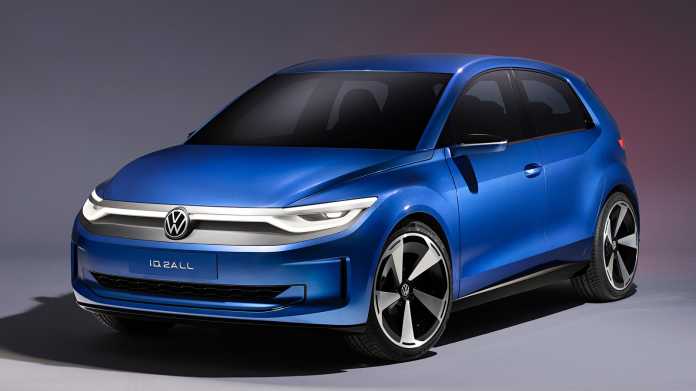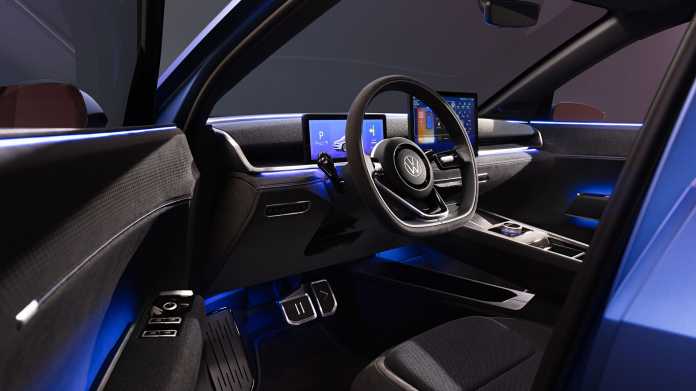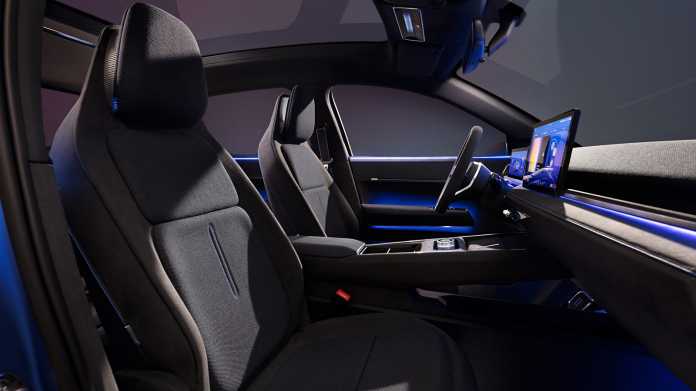Because of the price and the format, the world premiere of the ID.2all in Hamburg has the motto “for the people”. In this regard, a huge gap is currently opening up, especially with battery-electric cars. Hardly any small car with an electric motor is available for less than 30,000 euros. A level that not everyone can keep up with, even in affluent Germany. Prices have to come down if the turnaround in driving energy is to succeed. This is one of the reasons why the VW ID.2 was eagerly awaited. Is VW actually delivering a Volkswagen here again?

Unlike the other MEB vehicles, the ID.2all is based on the MEB Entry with front-wheel drive instead of rear-wheel drive. The advantage: there is more space on the rear axle. The trunk volume is 490 liters. There is a storage compartment under the rear seat bench and, unlike in the ID.3, the front passenger seat can be folded down. Enough length for the surfboard or daring car campers.
(Picture: VW)
Dimensions: Typical small car
At least the size should appeal to many European customers: At 4.05 meters, the ID.2all is about as long as a current VW Polo. For example, the (or is it?) Renault Zoe (test), Opel Corsa-e and Peugeot e-208 (test) are currently offered as electric cars in this class. All three are in high demand. At 1.81 meters, the ID.2all is the same width as the ID.3, which in turn is slightly lower at 1.53 meters in height.
Good space
Unlike the other vehicles from Volkswagen, which are based on the modular electrical system, the ID.2all has front-wheel drive instead of rear-wheel drive. An advantage of the front-wheel drive is a large trunk volume, because the electric motor and the multi-link axle are missing at the rear: Volkswagen specifies 490 liters, which is significantly more than the 381 liters of the Golf 8 – which is around 20 cm longer. Although the space available on the seats should not quite correspond to the Golf, the wheelbase of 2.6 meters is generous in this segment. If you are not constantly transporting four adults, you will probably be able to live with the space available.

This is what many electric cars currently look like from the inside: a small display in front of the steering wheel, a large one in the middle. That’s how it was first seen in the BMW i3.
(Picture: VW)
Target group: Private new car buyers
European buyers have different needs. The most powerful, largest and most expensive vehicles are almost always sold in Scandinavia. In Italy, France and Greece, on the other hand, small and compact cars are popular. The Golf was and is the sales champion, but cars like the Peugeot 208 follow closely. The ID.2all could actually be aimed at private buyers who are not only interested in the monthly leasing rate of a company car. The chance of being successful with a relatively conservatively designed car is definitely there.
“Target price” of less than 25,000 euros
That is the good news. However, the first technical data that VW reveals leave little doubt: what Volkswagen is announcing here will not be available for the basic version with the “target price” of less than 25,000 euros. The calculated range (it’s too early for the type test) is 450 kilometers. A value that can be expected from electric cars with around 60 kWh energy content in the traction battery. For cost reasons, we assume 40 kWh and 300 km in the statutory WLTP measuring cycle for the entry-level variant.

Rotary pushbuttons in the steering wheel and center console instead of the unfortunate sliders as in the previous ID series. Good this way.
(Picture: VW)
The performance specification of 166 kW for the electric motor – enough for under seven seconds to 100 km/h – and the wheel size 225/40 R20 point to a power version, the price of which should be well over 30,000 euros.
Only 20 minutes to 80 percent charge level
The charging time, which Volkswagen specifies, is independent of the energy content, and that is a statement: the charge from ten to 80 percent should be completed in 20 minutes. That’s just two minutes slower than the Hyundai Group’s E-GMP platform with electric cars like the Ioniq 5.
Volkswagen justifies this with a “particularly efficient drive, battery and charging technology”. Theoretically, this could be an 800-volt architecture, similar to Hyundai. However, we suspect that Volkswagen designed or purchased a 400-volt battery system with a complex cooling and heating system. Shorter loading times can also be achieved in this way.
(Bild: Daimler )
A three-phase AC charger with 11 kW will be standard. VW does not specify whether the battery in the ID.2all can be tapped externally as storage. VW has come up with a new position for the charging cable. There is a compartment for this under the rear seats instead of in the front or in the trunk. Hopefully the developers can come up with a solution how to get there with built-in child seats.
IQ-Light, Travel Assist and e-route planner
The ID.2all should at least optionally have the very good IQ.Light headlights and the Level 2 “Travel Assist” system. The e-route planner is also mentioned – we hope and expect that it will definitely be standard. With a functioning e-route planner, which automatically integrates charging stops and brings the traction battery to the right target temperature, even non-professionals can conveniently cover routes that are out of reach. Tesla has shown how simple this can be.

It is quite possible that VW will follow the strange fashion of glass roofs that cannot be opened in the ID.2all. That is not certain about two years before the start of sales.
(Picture: VW)
For 2025, Volkswagen forecasts a group-wide share of electric cars of 20 percent. So the original target of 25 percent has been revised downwards. From the perspective of the legal CO₂ fleet limits, this is easily possible, as our current analysis shows.
Competitors from Renault, Stellantis and from China
For customers in the so-called price-sensitive segment, it will be more pleasant in the next few years one way or another, because choice and competition will increase. Two particularly tough competitors will be launched just before the Volkswagen ID.2all: the Renault R5 electric (probably in late 2024) and the boxy Renault R4. Renault will soon hire the popular Zoe; the experience of ten years of electric cars is already clearly noticeable in the Megane E-Tech.
The Stellantis Group is currently redesigning the electric platform e-CMP. Among other things, the energy content of the traction battery increases to 54 kWh. The variety is great and ranges from the Opel e-Corsa to the Peugeot e-2008 and the Citroën e-C4 to the Jeep Avenger. Fiat will preview an electric interpretation of the Panda later this year. So when Volkswagen finally rolls the ID.2all to dealerships, it will have plenty of competition.
“Challenges” in electric cars for less than 20,000 euros
Until the actual start of sales of the VW ID.2all, which will not take place before 2025, the range of Chinese manufacturers could also grow. For example, how about exporting the BYD Dolphin to the European Union? Tesla may also play in this segment by then. The next E-Mini, on the other hand, will not be a direct competitor to the ID.2all. We expect that this will be significantly more expensive.
Volkswagen is meanwhile orienting itself downwards and in the press release on the ID.2all even promises to offer another electric car for less than 20,000 euros by 2026 “despite all the challenges”. That requires even more ambition and perhaps new cell technologies. For example, by replacing lithium with sodium.
Under no circumstances should it be forgotten that there will be other group branches based on the MEB Entry. Volkswagen is not yet revealing anything about this, but it is unlikely that this platform will only be used by the main VW brand. Similarly designed models from Skoda and Seat/Cupra are likely to be in preparation.
also read
Recommended Editorial Content
With your consent, an external survey (Opinary GmbH) will be loaded here.
Always load polls
(mfz)
